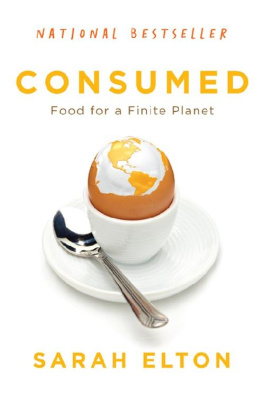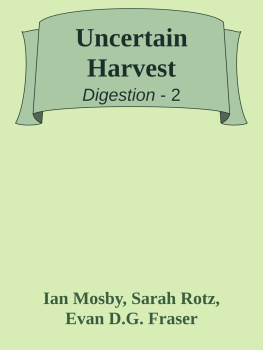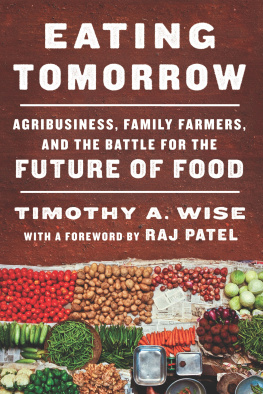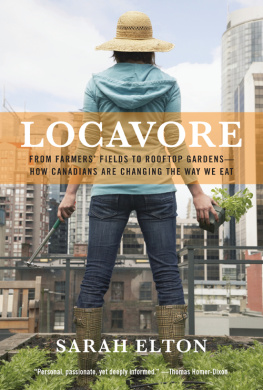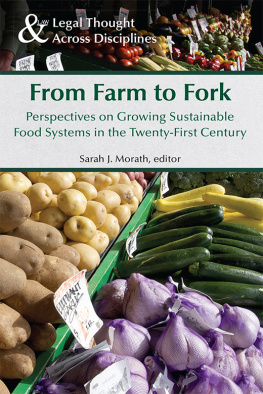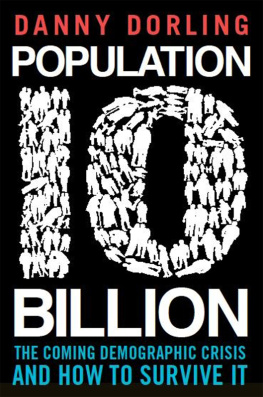CONSUMED
FOOD FOR A FINITE PLANET
SARAH ELTON


For Anisa, Nadia, and Kumail and for all of my family
You are a guest of naturebehave.
FRIEDENSREICH HUNDERTWASSER
CONTENTS
T o take a look into the future, all you need do is head to the Baltimore waterfront. On a few dozen square metres of urban green space, Lewis Ziska, a USDA scientist with the Agricultural Research Services Crop Systems and Global Change lab, found the same climatic conditions that climate models project will be the norm here on Earth sometime before the year 2050. That is, hotabout 1.5 to 2 degrees Celsius warmer than todays average temperatureand rich in carbon dioxide. Ziska used this small plot to watch in real time what effect climate change will have on the food we grow.
For his study, Ziska established two other test sites, one in the suburbs of Baltimore to simulate conditions expected in the 2020s or 2030s and another on an organic farm in Maryland to stand in for the present. (He couldnt build a laboratory to recreate these climates because funding for the kind of work he does had been cut by the federal government.) He introduced the same topsoil, with the same naturally occurring seeds, into these three landscapes and then waited to see how the different climates affected what grew. The goal was to see what species were going to be favoured, he explained to me.
The results were unsettling. What Ziska found over the course of the six-year study was that on the steamy, carbon-dioxide-rich Baltimore waterfront, weeds grew tallestin fact, they grew to be about two times larger than their rural counterparts. Lambs quarters, a common leafy weed, grew to between 2.5 and 3 metresabout double the height of its cousins on that organic farm in Maryland. Ragweed also fared much better under these future-like conditions. What we found, Ziska told me, was that the warming winter temperatures and the high carbon dioxide were all associated with a much greater increase in the weeds. Weeds are going to be a large issue when thinking about how much food we can produce.
For those of us who dont farm, tall weeds might not sound like a big deal. But for a farmer, weeds that would tower over even an NBA player are terrifying. Their giant stalks would likely jam machinery, shade even the tallest crops, and turn farming into an all-out war between the food plants and the weeds. Farmers use herbicides today to eliminate weeds before they grow, but research shows that as carbon dioxide levels increase, these chemicals are no longer as effective. That leaves weeding by hand. Of all the things that people do, that is the most time consuming and laborious aspect of growing food, said Ziska.
Giant weeds, resistant to herbicides, that must be pulled by hand: its science fiction come to life. We can safely conclude that weeds stretching to three metres would compromise our food security.
If we are concerned as a country for maintaining our national security, doesnt it make sense to remember food security? asked Ziska. It is an issue that is going to impact everyones lives in the not too distant future. And by everyone, he means everyoneno matter where you live, what you choose to eat, how much you spend on groceries. In some way, every one of us will be affected. Dr. Ziskas study raises the important question of how we will feed ourselves this century.
H ow will we feed ourselves in 2050? In the next forty years, the worlds population is expected to surpass nine billion. At the same time, climate change is transforming life on the planet. According to the scientists who look at these big-picture issues, in the space of about one generation, a messy combination of climate, population trends, and environmental change will profoundly affect the world as we know it. We need to figure out how to feed the world, dramatically reduce our greenhouse gas emissions, and cope with climate change.
So how do we best move forward? How do we ensure that everybody has enough to eat as we contend with a new climate? How do we do this without releasing even more greenhouse gases, thereby ruining the environment and further hampering the ability of future generations to feed themselves?
These pressing questions are forcing us to make a choice about how we want to tackle these problems, and a debate rages about which direction we should take. On one side of the debate is the route of sustainable food, with its organic farms and farmers markets, seed-saving networks, short food chains, and slow food traditions. On the other side is the path of the industrial food system.
Those who believe that industrial agriculture with its worldwide economy of food will best feed the planet argue that only a global industrial food system can provide the quantity of food we need at a low enough price for people to afford. Advocates tend to conjure up a Malthusian scenario of population outstripping food supply. The image of hungry teeming masses is even used to trump the idea of sustainabilityas if we as a species must make a choice between creating sustainable food systems and allowing children to die of hunger in Africa. In Foreign Policy magazine in 2010, Robert Paarlberg, a professor of political science at Wellesley College, slammed the sustainable food movement for what he called its elitist approach to food that excludes the poor. The subtitle summed it up: Stop obsessing about arugula. Your sustainable mantraorganic, local, and slowis no recipe for saving the worlds hungry millions. He concluded that only a globalized industrial food system can produce what we need, efficiently and cheaply, so that everyone is fed.
I disagree. I stand firmly on the other side of the debate and argue for sustainable food systems. While industrial food might provide ample quantities of cheap calories, if you want to feed people and protect their livelihoods given the state of the environment, the status quo doesnt cut it anymore. To feed the planet in a time of climate change, we need to build sustainable food systems. We must dramatically lessen the environmental burden of food production, encourage new economies of food that allow small-scale and family farmers to thrive in their rural communities, and nurture a food culture that connects us to the natural world on which we all depend. We must start to assemble these new, sustainable food systems immediately, because the rice, the bread, all the food we put on our plates, is at stake.
And without enough rice or bread, society starts to crack. Over the course of history, civilizations have fallen because their food systems have failed. In the Middle Ages, the Vikings disappeared from Greenland, where they had been living for several hundred years, because their farming methods eroded the topsoil and the climate changed, making it harder for them to grow food. In Central America, the Maya fled their cities, such as Guatemalas Tikal, when centuries of dry conditions, followed by drought, undermined their ability to sustain a dense urban population. The Roman Empire teetered into poverty and hunger after they overworked the soil on the plantations that supplied their busy cities. On Easter Island in the Pacific Ocean, as vividly described in Jared Diamonds book Collapse , the people who lived there cut down every last tree somewhere between the 1400s and the 1600s. Without trees, the Easter Islanders could no longer build the seafaring boats they had used to fish in deep waters; they soon hunted land birds into extinction. And without trees to protect the soil from erosion, farming dwindled. They were left with few food sources other than the flesh of their human neighbours. Archaeologists have found human bones in domestic middens, their ends rounded from being boiled in a pot.
Next page
